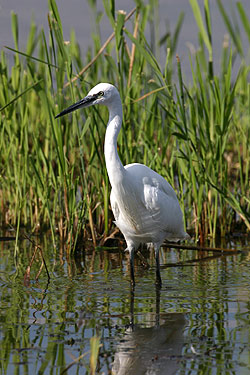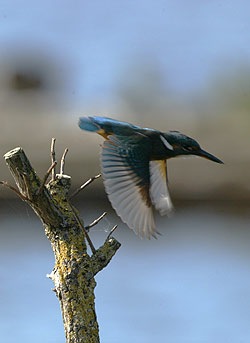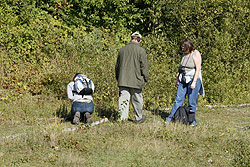Canon EF 400mm f/2.8 L IS USM
This professional offering from Canon in the fast super telephoto range, famous along the touchlines in its creamy grey ‘white’ livery is no lightweight contender in more ways than one. We take a look at how it performs.
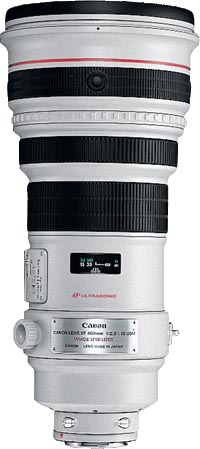 Specifications
Specifications
- Focal length 400mm
- Aperture f/2.8
- Angle of view 6.2º
- Filter size / type 52mm drop in
- Construction Elements/groups 17 elements in 13 groups
- Focusing type Internal USM (Ultra Sonic Motor)
- Closest focus 3m
- Weight 5.5kg
- Dimensions (Dia x length) 163x349mm
- Mounts available Canon,
- Tripod bush Yes (Supplied)
- Price (SRP) £ 5999
Build and handling
Supplied in a blow-moulded case of suitcase proportions this lens leaves you in no doubt of its professional status. The build quality is such that if it was run over by a truck, it might scratch the enameled finish. The tripod collar come carrying handle is of tow ball proportions!
Right in front of the mount is the 52mm drop in filter holder with neat, pinch grip release. The lens then expands in diameter before you get to the massive tripod bush collar with a knurled knob to tighten it. It rotates smoothly with slight clicks at the four compass points and carries a pair of strap mounts that, if anything seemed a little small, although very solid. The mount itself, which, if bolted to the back of a Land rover would pull a horsebox, has a pair of mounting points for differing camera weights. Forward of this is a distance window and to the left of it is the control panel consisting of five switches and a button. From top to bottom they are: a three-position focus limit switch (full, 3m-10m, 10m-infinity) flat switch, AF/MF raised switch, Stabiliser on/off raised switch, stabiliser mode 1-2 flat switch, focus pre-set on/off flat switch and a button to set the focus pre-set.
There then follows a large, two step manual focus ring that even large hands will not overlap but is still controllable with one finger such is the torque balance. A castellated ring follows this and is used by pushing the knuckles either way to return to the focus preset instantly. The ring is spring loaded to return to position. The facility is handy for setting the focus; say on a goalmouth or, for wildlife a favourite perch, that will need to be focussed on regularly during a shoot. A grip ring, with preset buttons at the poles is forward of this before the mounting for the aluminium bucket of a lens hood is fitted.
The whole thing worked well, with the autofocus being both fast and silent in operation. When first launched, Canon claimed it as one of the fastest in the world, although a few others can match it now. It was a joy to use once mounted on something to support the weight, as hand-holding is impossible for more than a single shot and even then it is difficult without some serious muscle! The IS system worked well, although the need to change modes to pan is a constant pain, especially as the switch is one of the flat ones! We would guess that most photographers use mode 2 and hope the tripod/monopod/beanbag takes care of the vertical movement for static shots.
Optical Quality
There is a huge amount of high quality glass in this lens, accounting for most of the weight. One fluorite and two UD elements are used to help control secondary spectrum. Certainly our test showed that there are no nasty surprised awaiting owners of this lens even when used with a converter, although pure resolution dropped a touch.
Suffice to say that, with everything taken into account, contrast, distortion, CA, OOF highlights etc, this lens produced excellent results.
| | |
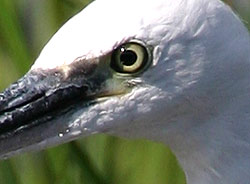 This crop of the larger, full frame picture of this Little Egret shows that the lens is still producing good results with a 2x converter fitted. Canon 1D + 2xEFII converter. 1/800sec at f/10. |
|
Click on each of these two comparison photos to view full size versions
Below is our lens test data. To find out how to use this graph look at this article: How we test lenses
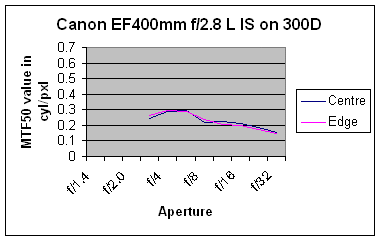
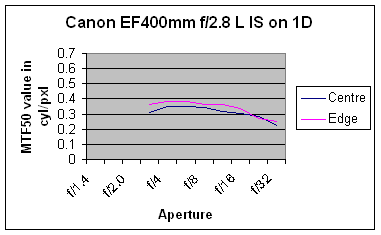
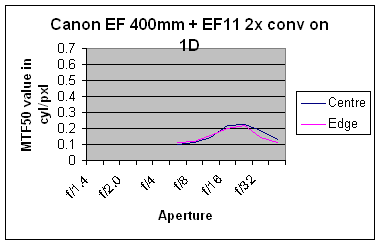
Verdict
If you have a professional need for a beast of this nature, or a bank balance and a back that can stand the hammering, you will not be disappointed. At f/2.8, it is a fast lens for its length and works ideally indoors under lights at such events as fashion shoots as well as on the touchline or a fast bend. It also combines well with Canon’s teleconverter range, still giving autofocus with the 2x. But be warned, this is the heaviest lens Canon produce!
In summary, the positive points of the Canon 400mm f/2.8 L IS USM are:
![]() Excellent optical performance
Excellent optical performance
![]() Good focus pre-set and Image stabilisation
Good focus pre-set and Image stabilisation
![]() Very solid build quality
Very solid build quality
The negative points are:
![]() Weight
Weight
![]() Price
Price
![]() IS modes and the switch to change them.
IS modes and the switch to change them.
Check the latest price for the Canon 400mm f/2.8 L IS USM here
Test by Ian Andrews www.wildaboutkent.co.uk
Photographed 06/2008
http://screeningroom.smugmug.com/gallery/5201545_Lon2m#315611384_ng67d
Anyone want to buy my wife? She's getting on a bit but fairly low mileage. Might consider straight swop for above!
David Chamberlain
This new (II) version of the lens drops several pounts of weight. Mounted on a 5d mkII, hand-holding this lens works for minutes at a time and isn't a problem. I'm very happy with the purchase -- fulfilled by Samy's Camera in CA -- a plus for those that are in WA state. I was lucky and got one from an early batch in December 2011.
Pros:
- Awesome image quality. Sharp over the full frame at f2.8. Non-existent distortion in all images I've looked at.
- Can hand hold it for useful periods of time.
- Extremely fast and accurate auto-focus.
- Great for distance portraits and sports.
More Detail : http://webcamerawebcamera.com/detail.php?id_detail=Canon-EF-400mm-f-2-8L-IS-USM-II-Super-Telephoto-Lens-for-Canon-EOS-SLR-Cameras-id141a&template=2
Add your message
Please login here or if you've not registered, you can register here. Registering is safe, quick and free.
photodo Stats
428 MTF tests
74 in-depth photodo reviews
100+ users join each day
Help the lens community by reviewing or rating a lens today via our lens search
Latest Lens Reviews
- Chinon 28mm f/2.8 Vintage Lens Review
- Canon EF 70-200mm f/4L IS II USM Lens Review
- Samyang AF 85mm f/1.4 EF Review
- Sigma 70mm f/2.8 DG Macro Art Review
- Samyang AF 24mm f/2.8 FE Review
- Meike 50mm f/1.7 Review
- Tamron 70-210mm f/4 Di VC USD Review
- Lensbaby Burnside 35mm f/2.8 Review
- Asahi Super Takumar 50mm f/1.4 Review
- Asahi Super-Multi-Coated Takumar 135mm f/3.5 Review
